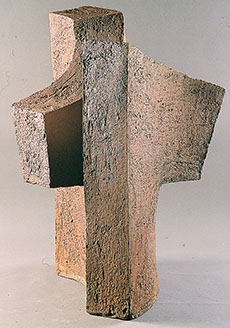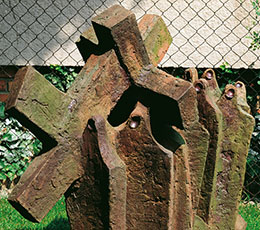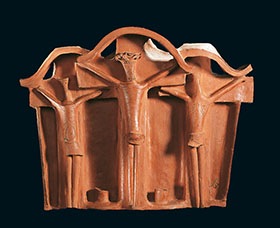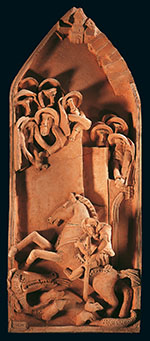St George’s Last Struggle with the Dragon
Árpád Csekovszky’s ceramist life work has a very well definable place and role of religious pieces. While the works dealing with the connection between horses and horsemen or the idol-motif, the emblematic mural pieces and sculptural city views can be found thorough his entire oeuvre, the sculptural appearance of religious topics can be connected to two important periods. Perhaps these were the time for estimation and evaluation. In the second half of the 1970s and also at the end of his career, in the 1990s, Árpád Csekovszky was seeking intensively for the synthesis of the artistic and religious approach in depiction of the facts. The stages of this path till the middle of the1970s can be briefly summed up like these:
All of his works demonstrate that he examines and analyses the possible manifestations of space, one of our most determinant experience of reality.
On the basis of the general view of philosophy the scene of our existence can be sensed in its relation to time, motion and mass substance.
Árpád Csekovszky was modelling this relation in his diploma work and also in his animal figurines made in the following years, moulding them from geometric objects (tubes, cylinders or cones) on the potter’s wheel.
Having improved this creative method, he developed a spatial man-made conformation in the field of plastic arts against the traditional modelling sculptures.
As he was experimenting with the analytical and explanatory possibilities of space in his sculptures, he explored such a disposal of masses and hollows, which he brought about by cutting through these masses, and also such displays of spaces surrounding the border of these splits that recall the forms and proportion of architecture. As a result of this exploration and artistic method, his objects modelled by stacking up the clay instead of using the wheel, his figurative works and bulky pots show the same monumentality as the horsemen and charioteer compositions, which were formulated from clay bands and slabs, and also the female torsos and idols, sculptural cityscapes, mural reliefs, constructive spatial compositions and religious representations.
Csekovszky, who was working by analyzing the connection between the abstraction and unambiguity of space besides modelling organic masses (animals, anthropomorphic pots, idols) and architectural compositions, laid special emphasis upon modelling the motif of horsemen and charioteers. They also represent an outstanding theoretical development. These works represent the connection between the organic (horse and horseman) and mechanical (chariot) structures and thus, they make perceptible the movement, a different factor of space.
The essential characteristics of the more organic equestrian statues from 1959 and the compositions that became basically structural to the middle of the 1970s can be estimated as the elements of sculpturesque manifestation of some philosophical recognition. A striking feature of the equestrian sculptures is that the bodies of the horsemen and the horses are formulated as one mass. The two organisms – the conscious and instinctive – coordinate their movements to reach a common goal. This coordination by the completion of their different mental and physical abilities for the sake of the common goal can be expressed with the unity of their bodies. The wheels of the chariot are also an important element of their expedient movement. They are integrated into the structure of the composition still explicitly kept apart from the organic forms. The idol-like form of the horseman gives the idea of the physical passivity of the man in opposition to the activity of the horse or rather their countermovement. As the wheels get more and more stress in the compositions, they make the movement more explicit as the medium of perception of the space. The number of the wheels and the setting of the composition cannot bear an interpretation which originates from the structure of the chariot. As a result of their repetitive accumulation and the rhythm of their arrangement, the accessible distance expresses a perpetually engaging system. Thus, the compositions of the charioteers also transfer a perceptible experience of the space via their movement.

For the 1980s the organic feature of Árpád Csekovszky’s charioteers fell into the background almost entirely.
His more and more angular figures and constructive compositions give an idea of some architectonical spatial effect.
This architectonical effect can be understood in the sense that Csekovszky furnishes a section of physical space with his built-in sculptural forms, as additive groups of the mass elements. This way he interprets for our sense organs the spatial extension, which is not filled in with tangible materials but, with the help of substantial plastic elements he makes it understandable as medium, because otherwise it would be beyond the reach of human understanding.
This artistic view and practice can be the result of such recognition that what is important is not the mere existence of the material which is formulated into objects but their role and disposition to break up the time of the motion into measurable items with the help of their relation to each other. Namely, examining the possible ways to how the phenomena of abstract space can be concretized and by using the means of the architectonic method, Árpád Csekovszky, too, arrived to the problems of the infinitude of space and eternity of time that have already been raised by religious ideologies.
From this point of view, I think, the multi-storey compositions of animal figures, Totem and Animal Composition (1961-1965) are important pieces of the oeuvre. They were made at the beginning of the 1960s and can be regarded to be the antecedents of the equestrian sculptures. The glazed ceramic figures moulded with hands are arranged in well understandable systems, in the groups of some geometrical forms of either bulls or some mythical beasts. This way these sculptures prepare the way towards the formulation of the questions in quest of the place and order of the organic existence in the physical space and time. Their mythical appearance also tries to create a kind of unity between the human and the supernatural existence.
Another approach to the same problem can be seen in Csekovszky’s reliefs and three- dimensional wall plastics connected to some architectural designs and also in his sculptural cityscapes and constructivist sculptures.
As a reminder, I want to stress that it is very important to recall and examine the different fields of the oeuvre as a whole if we want to understand Árpád Csekovszky’s religious pieces. That is why I think it is interesting to see what kind of artistic problems got more and more emphasis in the equestrian sculptures in the second half of the 1970s, and also which means of expression became mature to analyze and formulate these problems.
By his first period of seeking for synthesis in approaching the physical reality on the basis of faith and arts, Árpád Csekovszky had already completed about two thirds of his mural works. From this fact the conclusion can be drawn that he had already gained a lot and deep experience while he was modelling his original three-dimensional pieces as well as his many works which are connected to different buildings, and these helped him to understand and model the connection between the infinitude of the physical and architectonic space as well as to experiment with its perceptibility.

His three dimensional cityscapes, which could even grow into the size of a mural sculpture (In memory of an old city centre, Veszprém, 1976), can be seen as some possible formulation and interpretation of this experience. The most apparent characteristic of these sculptures is that the sight of the built environment of the city (modelled from ceramic straps and slabs) does not appear by the rules of the perspective or in the horizontally and vertically defined system of realty.
It seems as if we could look at some parts of a settlement from above and from different other angles at the same time. Nevertheless, it is unnecessary to elucidate the point of view.
The geometrically shaped masses that come into being at the meeting points of flat surfaces which do not close orthogonally together with their spaces, raise the number of the accepted quantity of the dimensions of the physical space. This suggests the impression of a synthesis of physical and transcendent reality. The sculptor also dealt with the problems of the visual sensation he had to face while he was designing his mural works and reliefs and was interested in how they can be applied to his circular sculptures. As a result, in the middle of the 1970s, his works titled Construction, Spatial construction and Prisms were brought to head.
The structural system that means the concentration of the forms of motion seems to become independent here on behalf of giving a chance for us to examine the possibilities of the rhythmic order of the masses and the boundaries of their vertical and horizontal stability. These works perambulate the capacity of these tectonic structures in creating and defining a certain place. The basic motives of these sculptures are the cubes and the prisms that both arouse the image of pillars and as such, that of the architectural picture of the big cities. One group of these constructions contains those ones where one of the lateral faces of their basic unit, the cube, is missing due to a certain system. The multi-storey compositions are built up from their solid and reticulated masses, and their negative spatial system of arrangement.
A peculiar unity of these spatial compositions is reflected in those ones which are superimposed on one another and so formulate into some prismatic sides out of square shaped panels with solid surface or a round hole in them. Thus, they imitate functionless supporting pillars. Other special varieties are those prisms whose building blocks are all deformed compared to the geometrical rules. They are constructed from curved square surfaces, split surfaced plane figures and groups of plane figures which protrude from fissures. These clay masses and their hollows and also the space they surround all analyse and interpret their relations to one another and to the physical perceptibility of the space. For 1970 this analysis and interpretation matured to the Sign, and the way the curved clay panels and straps interlock arouse the image of a cross.
„The cross as a symbol and also as a phenomenon was always very exciting for me because of its tectonic structure. Thus, I made more such prismatic compositions. I was mostly interested in the rhythm, the connection and the interdependence of the elements and later in the crosses that are standing in a niche – now as a crucifix – in their message.”- The master himself admitted it in the foreword of his catalogue in 1997.
The cross as a tectonic structure meant an especially important motive for Árpád Csekovszky, who was modelling the relation between the natural and architectonic spaces and seeking after the possible architectural means of expression for the visual representation of the natural space.
A composition evolved from the junction of a pillar and a beam can be interpreted as a peculiarly simplified horizontally and vertically determined presentation of reality. Meanwhile it is a steady sign-post and scale in relation to the human and superhuman measures when people are looking for orientation. Although it guarantees the perceptibility of natural space it does not limit its unity but allows flow its infinitude.
The bent crosses are important elements in the artist’s world of view. On the one hand, he cuts himself adrift from sticking to the geometrically co-ordinated view of the world; on the other, he refers evidently to the necessity to carry a cross before law-enforcement and also to the outstanding cross-bearer personality, Jesus Christ.

A leaning cross clearly expresses the one carried on a human shoulder. However, there is not only one cross-bearer figure in Árpád Csekovszky’s compositions but a multitude of crosses and masses of people. The figures are modelled idol-like and so they appear as passive participants of the situation. The posture of some of them recalls that they actually carry the cross while others might be condolers or those who actively help or have compassion on the sufferer. Their volitional or emotional connection to the situation cannot be verified from the composition.
The cross as the means of punishment for the faceless and limbless figures (without personality and the ability for any actions), who are excluded from the society, impresses the eternal sufferings of the ones in the infinitude of the space by its tectonic feature. A peculiar contradiction of the existence appears in these compositions, namely the antagonism of the social and historical determination of human existence and their transcendent perspectives.
Árpád Csekovszky’s compositions titled Bent Crosses (1976) and Cross Bearers (1974-77) have significant importance in the definition of the scale and perspectives of the human existence in connection with the eternal and infinite phenomena. While he was experimenting with the analytical role of the tectonic structure, he came across the problem of the final questions of human existence as well.
The similarity or even identity of the answers for the access to reality both artistically or on the basis of faith created a synthesis in this quest.
Having reached an ideological answer to the questions that were raised during the philosophical and architectonical examination of the space, he formulated it with using the motive of a tectonic structure bearing a sacred content. In the second half of the 1970s and from the beginning of the 1990s he modelled figural compositions that were built in niches. Almost all of them are based on religious themes.
The cross-bearer’s situation can well model the antagonism between the social and historical determination of the individual existence and its transcendent perspectives. A further expansion of this problem can be observed in the niches where we can see the different Stations of the Cross. (Way of the Cross, 1993). Their characteristic feature is that the scenes are shown in a limited space bordered by tectonic elements, in arched or Gothic niches.
This way Árpád Csekovszky definitely tried to model the idea of infinite in opposition with his earlier struggles to express its perceptibility. In these works he demonstrates the totality of the confidence he already found after having shown their perceptibility earlier.

The figures are built up from clay panels, straps and cylindrical elements. After the static presentment of the idol-like figures they, with their anatomically overstressed limbs, are active participants of their fates and shoulder their crosses. The organic formation of their bodies emphasizes their individual, material existence and as such, they are not mere compositional masses to help in the observation of the space. The bent crosses of the niche-sculptures often stick out from the niches – thus pointing beyond their concrete role in the given situation.
The compositional structure of the reliefs without crucifix shows close relation with the plastic cityscapes.
The presentation of the figures, furnishing objects or architectural elements are not applied either to the rules of the perspective or the horizontal-vertical determination. In a given spatial unit the sight of several views can come across together. The flat surfaces and axes of the motives intersect or cover each other in non-traditional angles. This method suggests the invalidity of the three-dimensional reality among the frames of the composition and at the same time it allows a possible presence of the transcendent. The scenes filled with transcendent message, which have some historic authenticity, are especially suitable to reflect the system of relations between the spiritual world and their physical appearance instead of the order and system of intuitions.
Typically representative iconographic examples of the ideas stated above are the following niche- reliefs: Ecce Homo (1992-93), The Last Supper (1992) and the Pieta (1992-93).
A special group of the religious works is the crucifixes and Golgothas which represent the cross in standing position. Árpád Csekovszky had already moulded some crucifixes at the end of the 1970s, but they became the characteristic motives of his work in the 1990s. He elaborated this traditional theme in the form of a niche-relief titled the Long-armed Christ in 1992.
The crucifixes and Golgothas recall the folkloristic atmosphere of his early pieces. The artist formed Christ’s body of cylinders, tubes and hemispheres, his body of a clay panel.

The cross is also built up from cylindrical elements which results in a decorative effect. It is also emphasized by the fact that the two ends of the shorter beam of the crosses are connected with an arch which bends over the peak of the long beam. These arches are often decorated with plastic motives. In the case of the Golgothas we can see this solution on all the three crosses.
The formation of the figures and the application of the plastic decorative elements which also recall some folkloristic atmosphere reflect the artist’s emotional attitude towards the crucifixion.
It is a feeling which can accept the resurrection with such relief that can decorate even the sign of the suffering with colourful motives.
Another variation to represent this theme was when he carved the negative print of the cross and the body of the crucified into a flat clay surface. This is a more staggering variation of the symbolic depiction that recalls the sculptures experiments with geometric two- or three- dimensional figures, and also with formulating the connection between the mass and space or the natural and architectonic spaces.

A negative space, as the place for the print of a given mass, indicates its spiritual existence by means of the lack of its material appearance and as such, it puts into shape the essence of the resurrection in the language of the sculptural art.
The unity of Árpád Csekovszky’s religious pieces is represented by the reliefs, niche figurines, mural pictures and other figurettes depicting St George killing a dragon. This topic runs thorough his whole oeuvre. The first known piece in this theme is from 1965, and his last relief, which was left without baking also, formulated the martyr soldier of the Roman Empire.

Dealing with this subject matter we cannot avoid the comparison between the approach to St George’s equestrian figure and the horsemen of the charioteers’.
The difference in the stimuli which motivated the creation of these groups of works explains the difference in their plastic and artistic approach.
The compositions of the charioteers were analysing the kymograph connection in the relation of the organic and geometric structures and their abilities to create some spatial perceptiveness. They also interpreted the unambiguousity of the abstract space and its reference to infinitude.
However, in St George’s figure the transcendent reality is expressed as his existence is attested by history. This way his material appearance can also allow some anatomical references and not only mere organic plastic forms.
He can always be seen in the basic form of the fight, when, sitting on his horse, he spears the body of the dragon. He is often surrounded with cityscape elements and excited people waiting for his victory.
The contrasting duality of St George and the dragon fills the fights with some real concretization which was also observable in the composition of the Bent Crosses or the Cross Bearers. Nevertheless, it appeared there among its abstraction and transcendent perspectives, in the socio-historical determination of the human existence.
Perhaps St George’s popularity till our days is owing to the fact, that although he was forced into martyrdom for he was excluded from the society as a kind of outcast, he could contribute to the survival of the community by defeating the dragon, the embodiment of the evil. Because of this heroism, the legend regards him to be St Michael’s mortal fellow-fighter and his horse is identified with Christ’s apocalyptic white horse.

So, St George’s figure can include the possibility to extend the historic time into infinity and as such, he can be a constant character of human history from the 3rd or 4th century up to the day of the Last Judgement.
Árpád Csekovszky found the synthesis of his artistic and religious knowledge of the world while examining the rules of the connections between the natural and architectonic spaces and the relations among mass, motion, time and space.
For him the contradiction between the socio-historical determination and transcendent perspectives of the human existence could be solved in the figure of St George.
Having found this solution, he could place the Saint’s equitation figure into the cityscape of Pécs, which also refers to the spatial arrangement of some transcendent reality. And he could also represent him in an independent plastic setting. That is why he could model the victorious St George either as a lone hero or amongst the crowd who long for his victory.
